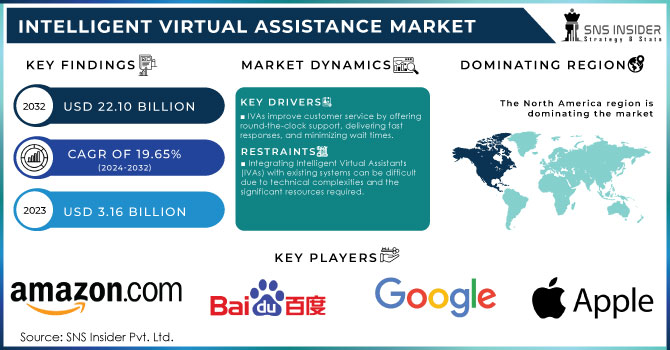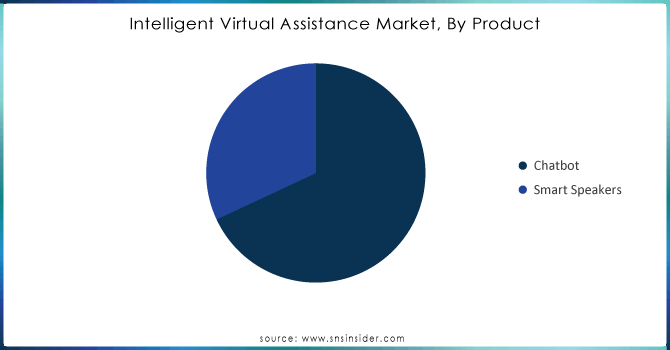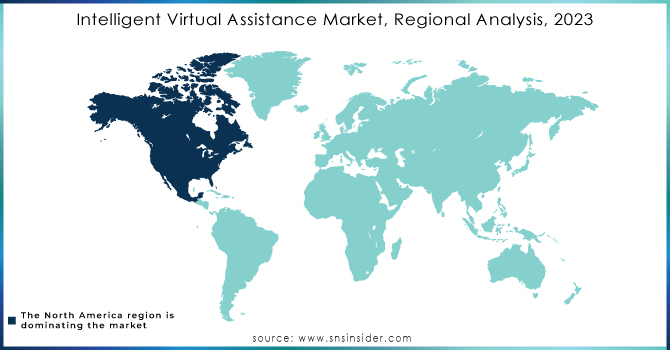Intelligent Virtual Assistance Market Report Scope & Overview:

Get more information on Intelligent Virtual Assistance Market - Request Sample Report
The Intelligent Virtual Assistance Market Size was valued at USD 3.16 Billion in 2023 and is expected to grow to USD 22.10 Billion by 2032 and grow at a CAGR of 19.65% over the forecast period of 2024-2032.
The growing adoption of intelligent virtual assistants (IVAs) is a crucial factor in this growth, as businesses utilize these AI-driven systems to enhance customer service, streamline operations, and reduce costs. IVAs have evolved from simple chatbots to sophisticated digital assistants, capable of handling complex queries, understanding natural language, and providing personalized responses. A significant trend in the VA market is the integration of natural language processing (NLP) and voice recognition technologies, which enhance the ability of virtual assistants to understand and respond to user inputs effectively. This improvement has made IVAs increasingly useful across various sectors, including healthcare, e-commerce, and banking, where automating routine customer interactions can greatly enhance efficiency. Additionally, IVAs are being designed to support multiple languages, making them accessible to a global audience.
Another noteworthy trend is the growing demand for omnichannel capabilities. Consumers interact with businesses across various platforms such as websites, mobile apps, and social media. As a result, IVAs are being deployed to ensure consistent and seamless customer experiences across all channels, which helps improve customer satisfaction and retention while maintaining brand consistency. The shift towards cloud-based platforms is also accelerating the growth of virtual assistants. Businesses are favoring cloud-based IVAs over on-premise solutions due to their scalability, cost-effectiveness, and ease of integration with other enterprise software. This trend is especially beneficial for small and medium-sized enterprises (SMEs) that seek affordable solutions to enhance customer engagement.
Additionally, the deployment of IVAs for internal corporate use is on the rise. Companies are implementing virtual assistants to automate HR tasks, improve internal communications, and provide IT support, leading to increased productivity and reduced burdens on human resources teams. The 40% of large businesses globally utilize virtual assistants, and the implementation of IVAs can reduce call center volumes by up to 50%, allowing human agents to focus on more complex issues. Furthermore, companies leveraging IVAs report a 30-40% reduction in customer service costs and significant increases in response times and customer satisfaction, with satisfaction scores rising by 20-25%. With continued advancements in AI and automation, the VA market is poised for further growth, promising more integrations with emerging technologies such as the Internet of Things (IoT) and advanced robotics.
Intelligent Virtual Assistance Market Dynamics
DRIVERS
- IVAs improve customer service by offering round-the-clock support, delivering fast responses, and minimizing wait times.
Intelligent Virtual Assistants (IVAs) significantly enhance customer experience by offering 24/7 support, ensuring that users receive timely responses without the need to wait for human intervention. This constant availability helps businesses meet customer expectations in today’s fast-paced digital landscape, where delayed responses can lead to customer dissatisfaction and loss of business. IVAs handle a wide range of tasks, from answering FAQs to resolving basic issues, allowing customers to get quick solutions without involving human agents. The 75% of consumers expect immediate responses, which IVAs effectively deliver.
Moreover, by utilizing advanced technologies like Natural Language Processing (NLP) and Machine Learning (ML), IVAs can engage in more natural, human-like conversations, enhancing customer interaction quality. According to research, companies using AI-powered assistants see a reduction in average response times by up to 60%. This translates to improved customer loyalty and satisfaction, as consumers feel valued when their issues are addressed swiftly. Additionally, the reduction in waiting times allows human agents to focus on more complex inquiries, leading to better resource allocation and more efficient customer service operations. However, the success of IVAs largely depends on the ability to provide accurate, context-aware responses. This can sometimes be a challenge with more nuanced or complex inquiries, but ongoing advancements in AI are improving IVA capabilities over time.
- Advancements in AI, including Natural Language Processing (NLP) and Machine Learning (ML), enhance the efficiency and adaptability of Intelligent Virtual Assistants (IVAs).
Advancements in AI, particularly in Natural Language Processing (NLP), Machine Learning (ML), and conversational AI, are significantly improving the efficiency and adaptability of Intelligent Virtual Assistants (IVAs). NLP allows IVAs to understand and generate human language more naturally, making interactions feel seamless. For example, NLP's accuracy in recognizing intent has reached over 90% in some cases, enabling better customer experiences. ML enhances IVAs' ability to learn from interactions and improve over time, adapting responses to user behavior and preferences. Conversational AI, which combines NLP and ML, allows IVAs to engage in complex dialogues, maintaining context throughout interactions. These improvements not only increase efficiency but also enable personalized customer service at scale. As a result, businesses are increasingly adopting IVAs for tasks ranging from customer support to scheduling, with industries like banking, healthcare, and retail leading the charge.
However, despite these advancements, AI-driven IVAs still face challenges. For instance, fully understanding nuanced language or highly specific industry jargon can be difficult, although ongoing innovations in NLP are continually addressing these gaps. The continuous development of these AI technologies ensures that IVAs will become even more effective in automating routine tasks and handling more sophisticated requests in the future, making them a critical tool for modern businesses looking to enhance operational efficiency and customer engagement.
RESTRAIN
- Integrating Intelligent Virtual Assistants (IVAs) with existing systems can be difficult due to technical complexities and the significant resources required.
Integrating Intelligent Virtual Assistants (IVAs) into existing systems can be complex and resource-intensive for several reasons. First, businesses often have legacy systems that are outdated or lack the flexibility required to integrate modern AI-driven technologies like IVAs. Ensuring compatibility between these systems can require significant development time, custom coding, and testing. Additionally, IVAs need to connect with various databases, customer relationship management (CRM) systems, and communication channels like email or voice platforms, further complicating the integration process.
Another challenge is data synchronization. IVAs rely heavily on real-time access to customer information and service histories, which means that businesses must ensure seamless data flow between systems. This can involve configuring secure APIs, handling large volumes of data, and addressing privacy concerns, which requires considerable technical expertise and resources. Moreover, post-integration, businesses must ensure continuous monitoring, updates, and scaling of these systems as customer demands or technology evolves. Without proper investment in both time and expertise, the IVA may not perform optimally, leading to subpar user experiences or operational inefficiencies.
Intelligent Virtual Assistance Market Segmentation Analysis
By Product
In 2023, the chatbot segment dominated the market share over 68.05% of the total revenue. This dominance can be attributed to the increasing demand for automated customer service solutions across various sectors, including e-commerce, healthcare, and finance. Chatbots enhance user experience by providing instant support and personalized interactions, significantly reducing wait times and operational costs. Businesses leverage AI-powered chatbots to handle inquiries, streamline processes, and improve customer satisfaction. The integration of natural language processing and machine learning further enhances their capabilities, allowing for more sophisticated conversations.

Need any customization research on Intelligent Virtual Assistance Market - Enquiry Now
By Technology
In 2023, the text-to-speech (TTS) segment dominated the market share over 62.02% of the overall revenue. This leadership can be attributed to the increasing adoption of TTS technology across various sectors, such as education, healthcare, and customer service, where accessibility and user-friendly experiences are prioritized. TTS tools convert written text into spoken words, making digital content more accessible to visually impaired individuals and enhancing productivity for users who prefer auditory learning or multitasking. The rise of virtual assistants, audiobooks, and other AI-driven applications has further fueled the demand for TTS solutions, solidifying its dominance in the market.
Intelligent Virtual Assistance Market Regional Overview
In 2023, North America region dominated the market share over 32.06%. This dominance can be attributed to the increasing trend of Bring Your Own Device (BYOD), which has facilitated remote work, allowing virtual assistants to enhance productivity and efficiency in various sectors. Particularly within healthcare, IVAs have been embraced for their potential to streamline processes, improve patient care, and boost operational effectiveness.
U.S. based virtual assistants (VAs) are the highest earners globally, with around 91% possessing college degrees, reflecting a highly educated workforce. As of 2022, approximately 285,028 VAs were employed in the U.S., with a majority being women (83%) and mostly over the age of 40. Many companies choose to hire VAs to cut costs, achieving savings of up to 78% compared to full-time employees. Moreover, the remote work environment enhances productivity, with many VAs reporting high job satisfaction 93% are inclined to remain in their positions. This positive trend underscores the evolving nature of work and the essential role VAs play in efficiently supporting business operations.
The Asia-Pacific (APAC) region is projected to experience the fastest growth in the IVA market, driven by the rapid expansion of retail and consumer electronics in countries like China. The adoption of AI-powered IVAs is rising as businesses recognize their capabilities in automating tasks such as appointment scheduling and customer consultations. Innovative product launches that enable applications and devices to function as intelligent agents further support this growth, underscoring the transformative role of IVAs across multiple industries.

Key Players in Intelligent Virtual Assistance Market
Some of the major key players of Intelligent Virtual Assistance Market
- Amazon.com, Inc. (Alexa)
- eGain Corp. (eGain Assistant)
- Apple Inc. (Siri)
- Baidu, Inc. (DuerOS)
- Next IT Corp. (Alme)
- Clara Labs (Clara)
- CSS Corp. (CSS Corp's Virtual Agent)
- Welltok, Inc. (Welltok's Virtual Health Assistant)
- Creative Virtual (V-Person)
- CodeBaby Corp. (CodeBaby Virtual Assistant)
- Google Inc. (Google Assistant)
- IBM Corp. (Watson Assistant)
- Kognito (Kognito Virtual Agents)
- Microsoft Corp. (Cortana)
- MedRespond (MedRespond Virtual Assistants)
- Nuance Communications, Inc. (Nuance Virtual Assistant)
- Oracle Corp. (Oracle Digital Assistant)
- True Image Interactive, Inc. (Virtual Sales Assistant)
- Verint (Verint Intelligent Virtual Assistant)
- LivePerson, Inc. (LiveEngage)
List of Suppliers
- Amazon Web Services (AWS)
- Google Cloud
- Microsoft
- IBM
- Nuance Communications
- Salesforce
- Rasa
- Ada
- IPsoft
- LivePerson
RECENT DEVELOPMENT
In 2024: The Intelligent Virtual Assistance Market is set to revolutionize in-car experiences as Mercedes-Benz introduces the MBUX Virtual Assistant, featuring generative AI for hyper-personalization at CES 2024.
In 2024: Tecno introduced its AI Vision and Ella virtual assistant at IFA 2024, enhancing user productivity with advanced features like smart Q&A, real-time translation, and AI-assisted writing. The assistant, powered by Google Gemini, aims to streamline everyday tasks and improve communication, showcasing Tecno's commitment to AI integration in consumer devices.
In 2024: Apple has launched an AI software update for Siri, enhancing its capabilities on the iPhone 16, which was released shortly after the announcement. This update aims to make Siri more conversational and efficient, with a range of new features for automating tasks.
| Report Attributes | Details |
|---|---|
| Market Size in 2023 | USD 3.16 Billion |
| Market Size by 2032 | USD 22.10 Billion |
| CAGR | CAGR of 19.65% From 2024 to 2032 |
| Base Year | 2023 |
| Forecast Period | 2024-2032 |
| Historical Data | 2020-2022 |
| Report Scope & Coverage | Market Size, Segments Analysis, Competitive Landscape, Regional Analysis, DROC & SWOT Analysis, Forecast Outlook |
| Key Segments | • By Product (Chatbot, Smart Speakers) • By Technology (Automatic Speech Recognition, Text to Speech, Text based) • By Application (BFSI, Consumer Electronics, Automotive, Healthcare, Education, Retail, IT & Telecom, Travel & Hospitality, Others) |
| Regional Analysis/Coverage | North America (US, Canada, Mexico), Europe (Eastern Europe [Poland, Romania, Hungary, Turkey, Rest of Eastern Europe] Western Europe [Germany, France, UK, Italy, Spain, Netherlands, Switzerland, Austria, Rest of Western Europe]), Asia Pacific (China, India, Japan, South Korea, Vietnam, Singapore, Australia, Rest of Asia Pacific), Middle East & Africa (Middle East [UAE, Egypt, Saudi Arabia, Qatar, Rest of Middle East], Africa [Nigeria, South Africa, Rest of Africa], Latin America (Brazil, Argentina, Colombia, Rest of Latin America) |
| Company Profiles | Amazon.com, Inc., eGain Corp., Apple Inc., Baidu, Inc., Next IT Corp., Clara Labs, CSS Corp., Welltok, Inc., Creative Virtual, CodeBaby Corp., Google Inc., IBM Corp., Kognito, Microsoft Corp., MedRespond, Nuance Communications, Inc., Oracle Corp., True Image Interactive, Inc., Verint, LivePerson, Inc. |
| Key Drivers | • IVAs improve customer service by offering round-the-clock support, delivering fast responses, and minimizing wait times. • Advancements in AI, including Natural Language Processing (NLP) and Machine Learning (ML), enhance the efficiency and adaptability of Intelligent Virtual Assistants (IVAs). |
| RESTRAINTS | • Integrating Intelligent Virtual Assistants (IVAs) with existing systems can be difficult due to technical complexities and the significant resources required. |

